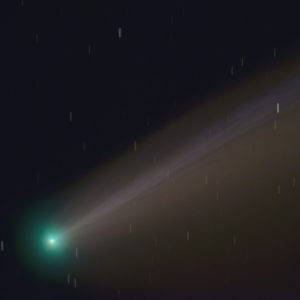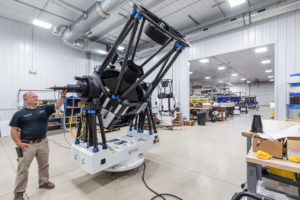Baader Planetarium Blog Posts
-
Optical Detectors for the Discovery of Transiting Exoplanets (Post by Andor Technology)
This entry was posted on October 26, 2020 Last modified on February 19, 2024.
The transit method is currently one of the most successful indirect techniques to detect extrasolar planets. To date, over 3800 exoplanets were discovered, from which the majority was found using the transit method. This technique is based on observations of a planet passing in front of its host star (= transit), as seen from an observer on Earth. The planet in transit blocks a fraction of the stellar light and thus causes the stellar brightness to decrease periodically. This periodic dimming of the stellar light is measured in terms of a transit light curve. Read more about the challenge background and the technology solution on Andor Technology's website >>>
-
Optical Etaloning in Charge Coupled Devices (Post by Andor Technology)
This entry was posted on October 26, 2020 Last modified on February 19, 2024.
In the field of modern scientific-grade CCD detectors the arrival of back-illuminated CCDs and Electron-Multiplying EMCCDs has offered key enabling technology for the growing range of applications where the photon signal available is extremely low. Such applications include low-light cell microscopy and fast chemical mapping. On the webpage of Andor Technology presents one of the key challenges associated with the use of back-illuminated, CCDs for Near-Infrared (NIR) detection, namely optical etaloning, and outlines with particular reference to a manufacturing process called ‘fringe suppression’. Read more about the Optical Etaloning in Charge Coupled Devices on Andor Technolog's website>>>
-
Baader Custom Developments for telescope installations
This entry was posted on August 7, 2020 Last modified on February 19, 2024.
We received a question from our customer about our turn-key telescope solutions. It was actually only a short question, but we answer it in detail to show you what kind of benefit it provides, when ordering a complete telescope system from us. The question: Could you tell me what the OTA rings on the TEC140 in the attached image (from a Baader installation) are. I can see that the outer rings are the Baader heavy duty rings but what out the inner rings (inside the larger, outer rings). Do you sell these inner rings? Our answer: In short: Unfortunately we cannot offer these as regular purchasable products. In detail: these inner rings are always specially made for each complete telescope project where we supply all instrumentation...
-
Spikes with Astro-Amici Prisms
This entry was posted on May 5, 2020 Last modified on February 16, 2024.
I see spikes on bright objects - is my prism defective? Concerning Amici prisms, there are two factors which can limit the use for astronomy. The first one is the optical quality, i.e. how good is the alignment of the optical surfaces. Most Amicis are made for terrestrial use, where our atmosphere limits the useable magnification to ca. 60x or 70x, anyway. So, it's fine if they don't show a double image up to ca. 100x, as such high magnifications can't be used. Those prisms which are designed for astronomical use are designed for those magnifications which we can use for the night sky – ca. 300x or even more. This high precision makes our Astro-Amici star diagonals so expensive. But all Amici-prisms – no...
-
Comet Neowise in a different way
This entry was posted on July 23, 2020 Last modified on February 28, 2024.
Comet NEOWISE is probably the most beautiful comet since 25 years on the northern hemisphere of the earth. Comets are messengers from the time of origin of the solar system, frozen remnants of the primeval cloud from which the planets were formed. When they come to us from the cold depths of the outer solar system and thaw when they approach the sun, they spread gas and dust and create a unique celestial phenomenon. Most astrophotographers are understandably excited about the very beautiful tail of the comet NEOWISE and try to capture it in front of a beautiful backdrop. Others focus only on the inner core and the shell structure that is created when the dust leaves the spinning comet nucleus. But so far there...
-
PlaneWave: new location, favorable pricing
This entry was posted on July 16, 2020 Last modified on February 28, 2024.
PlaneWave Instruments is focused on vertical integration – from the very beginning. Design, optical production, fabrication, assembly, and quality control are all performed in-house by their expert team. PlaneWave even designs and builds their own robotic optics machines. PlaneWave's approach and innovation allows them to create superior products and value for their customers. Over the last few years there was just one little issue: PlaneWave had outgrown their facilities in California and in Michigan. It was time to reoptimize. New Location: 2020 marks the first full year on PlaneWave’s new 57-acre campus in Adrian, Michigan. PlaneWave has joined their MI and CA operations reducing overhead gaining a larger campus, and providing countless opportunities to expand. New Facilities: PlaneWave is evolving and growing. With new buildings, machines,...
-
QHY 5-III-462C
This entry was posted on June 24, 2020 Last modified on February 28, 2024.
Don't settle for less! UPDATE 02.03.2018: We have underestimated the increased demand for the QHY 5-III-462C CMOS Camera (#1931026 , € 295,-) . The camera is now available in sufficient quantities. The new QHY5III 462C - a RGB single shot color camera with high quantum efficiency and high sensitivity in the near infrared spectral range at an attractive price The QHY 5-III-462C CMOS Camera (#1931026 , € 295,-) is actually two CMOS-cameras in one camera body. With it you can take normal single shot color images of the planets of the solar system, as well as of sun and moon. Due to the extremely low readout noise, RGB images of brighter DeepSky objects can be captured with the Lucky Imaging technique at shorter exposure times,...
-
New products Juli 2020
This entry was posted on July 21, 2020 Last modified on February 28, 2024.
Baader OTP II Outdoor Telescope Power Switch 12,8V / 1,5A 19W with elbowed plus Made for outdoor use at cold temperatures Interchangeable EU/US/UK wall plug included Output 12.8V DC/ 1.5 Amp (19 Watt), large power reserve even when cold - usable in temperatures from -25°C up to 40°C 2.5m (8.25') telescope cord incl. reverse polarity protected, elbowed protective-disconnect plug 5.5mm / 2.1mm Not waterproof IP40 Successor model of the previous 19W Outdoor Power Supply #2457610 (discontinued). V-Dovetail, 495 mm for Celestron RASA 8" V-Dovetail for Celestron RASA 8" optical tube, length = 495mm Aluminium body provides a sturdy platform for accessories Connects on the top of the Rowe-Ackermann Schmidt Astrograph 8" to attach accessories to the optical tube Installs easily into the existing holes of...
-
Image Gallery: Comet C/2020 F3 NEOWISE
This entry was posted on July 9, 2020 Last modified on February 28, 2024.
Since we now receive new pictures of NEOWISE daily (from our employees as well as our customers), we have decided to only maintain the following picture gallery. Information about the comet as well as search maps can be found at various other places on the net. Here you see only new beautiful pictures and videos, which we will be permanently extended. Some of the pictures we already showed in our original NEOWISE article (with an update). If you have any further questions about image data, please contact us - we only mention the copyright holders and the date of recording of the respective images here. Images of Comet NEOWISE (Videos see below) © M. Jäger – 23.07.2020© B. Koch – 22.07.2020© C. Kaltseis –...
-
SUW 08/20: In the Heart of M42 with a C14 EdgeHD
This entry was posted on July 8, 2020 Last modified on February 28, 2024.
THE STORY: In the Heart of M42 When we were still shooting on film, it was just like today: The Orion Nebula has always been on the most-wanted-list of practically every astrophotographer. This starts with wide field shots and ends with detailed images of the surroundings of the trapezoid stars in the heart of M42. This region of M42 is much brighter than the faint surroundings, and this enormous dynamic range makes photography especially tricky. The structures require a long focal length and a wide aperture to let them shine. For my imaging I chose Celestron's C14 EdgeHD, which is still compact despite its size and therefore doesn't require an gigantic mount. At an f/ratio of f/7.6 with the special reducer designed for full-frame cameras, I...














